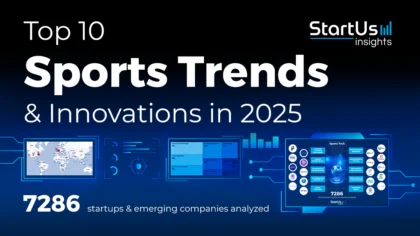Driven by evolving fan expectations and a growing push for equity and sustainability, the sports industry is entering an era of change. Major sports trends to watch out for this year are virtual and phygital sports, emerging coaching technologies, innovations for female athletes, and smart stadium experiences. At the same time, a stronger focus on athlete wellness and eco-friendly practices is enhancing athlete performance and fan loyalty.
Organizations that lead this evolution will unlock new opportunities and set the pace for the next wave of growth. Riding this momentum, the global sports market is projected to grow to USD 651.01 billion by 2028 at a rate of 6.1%, and to USD 862.59 billion by 2033 with a CAGR of 5.8% from 2028 onward.
What are the Top 10 Sports Trends in 2025?
- Coaching and Training Technologies
- Virtual and Phygital Sports
- Innovations for Female Athletes
- Fan Engagement and Experience
- Sports Wearables
- Advanced Sports Equipment
- Smart Stadiums and Venues
- Tech-Assisted Match Analysis
- Athlete Wellness and Mental Health
- Sustainable Sports
Methodology: How We Created the Sports Trend Report
For our trend reports, we leverage our proprietary StartUs Insights Discovery Platform, covering 7M+ global startups, 20K technologies & trends plus 150M+ patents, news articles, and market reports.
Creating a report involves approximately 40 hours of analysis. We evaluate our own startup data and complement these insights with external research, including industry reports, news articles, and market analyses. This process enables us to identify the most impactful and innovative trends in the sports industry.
For each trend, we select two exemplary startups that meet the following criteria:
- Relevance: Their product, technology, or solution aligns with the trend.
- Founding Year: Established between 2020 and 2025.
- Company Size: A maximum of 200 employees.
- Location: Specific geographic considerations.
This approach ensures our reports provide reliable, actionable insights into the sports innovation ecosystem while highlighting startups driving technological advancements in the industry.
Innovation Map outlines the Top 10 Sports Industry Trends & 20 Promising Startups
For this in-depth research on the Top Sports Trends & Startups, we analyzed a sample of 7286 global startups & scaleups. The Sports Industry Innovation Map created from this data-driven research helps you improve strategic decision-making by giving you a comprehensive overview of the sports industry trends & startups that impact your company.
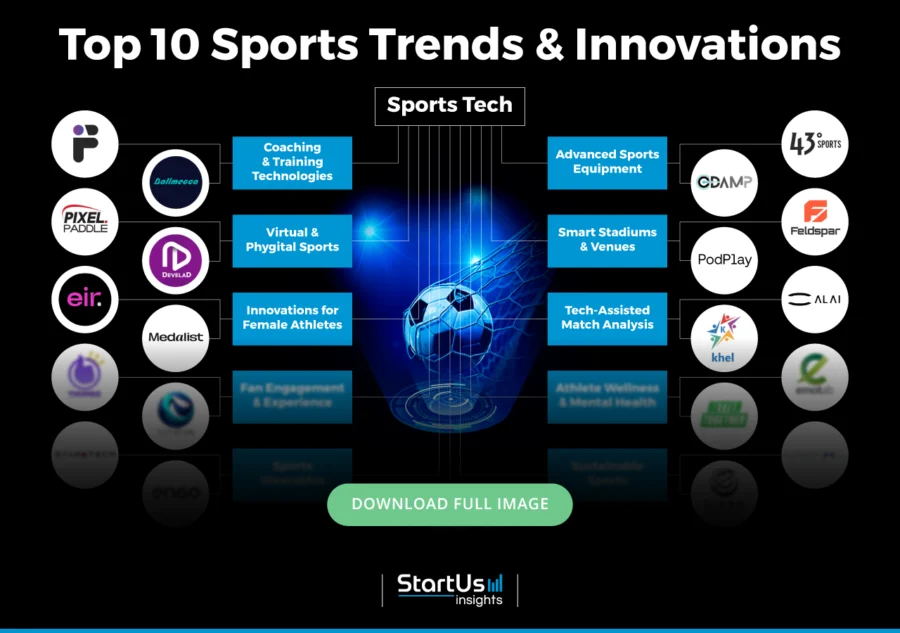
Tree Map reveals the Impact of the Top 10 Trends in Sports
The Sports Industry Tree Map showcases the Top 10 Sports Trends in 2025. Industry leaders and emerging startups are driving advancements in coaching and training technologies, virtual and phygital sports, innovations for female athletes, and athlete wellness. They are also reimagining fan experiences, designing smart stadiums, developing advanced equipment, and integrating sports wearables.
As organizations invest in tech-assisted match analysis and prioritize sustainability, they continue to reshape how fans engage, athletes perform, and sports generate value. These trends reflect how the industry actively adapts to evolving expectations and uses innovation to redefine the future of sports.
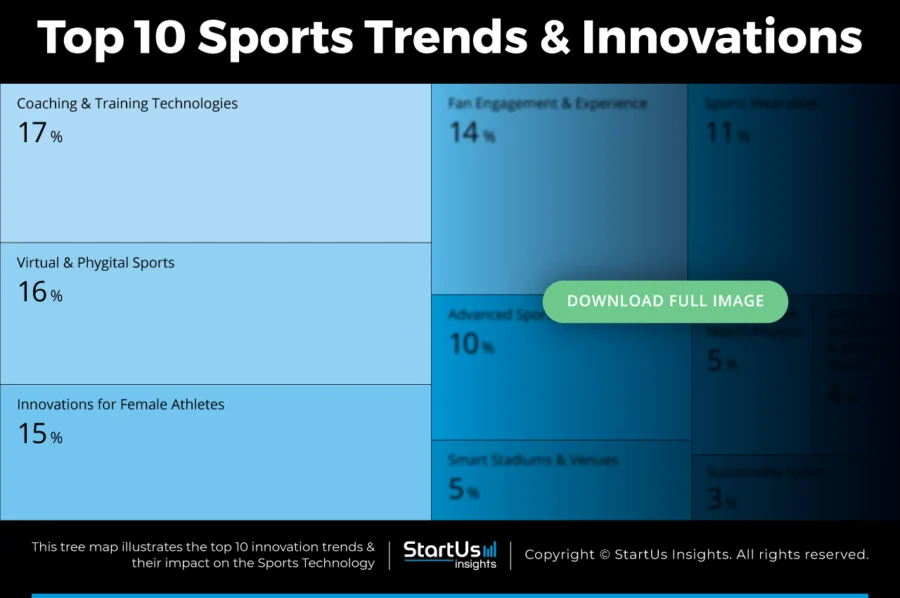
Global Startup Heat Map covers 7268 Sports Startups & Scaleups
The Global Startup Heat Map showcases the distribution of 7268 exemplary startups and scaleups analyzed using the StartUs Insights Discovery Platform. It highlights high startup activity in the US and India, followed by the UK and France. From these, 20 promising startups are featured below, selected based on factors like founding year, location, and funding.
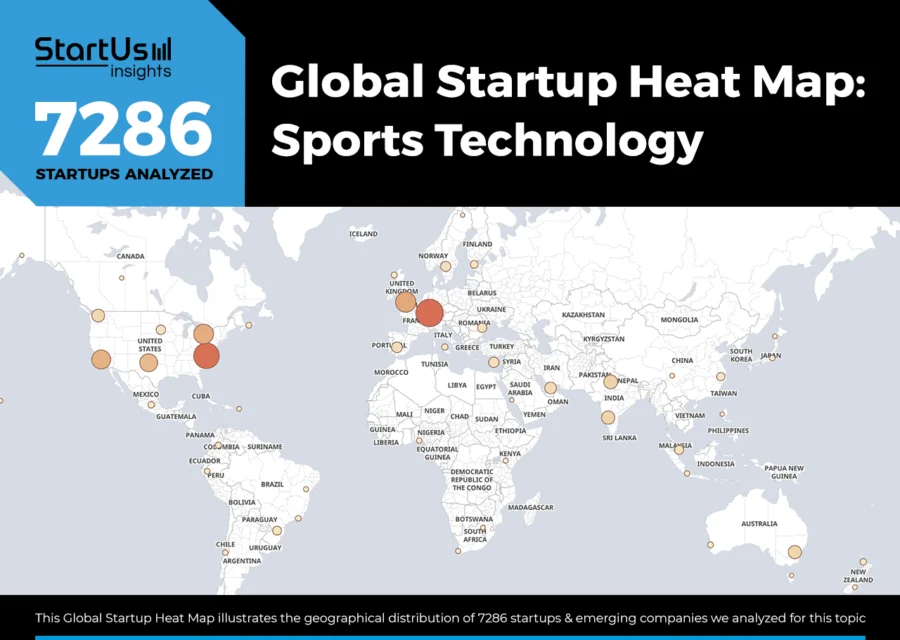
Want to Explore Sports Innovations & Trends?
Top 10 Emerging Sports Technology Trends [2025 and Beyond]
1. Coaching and Training Technologies
As performance standards rise, athletes and coaches adopt intelligent training solutions to gain a competitive advantage. The sports coaching market is projected to grow by USD 4.77 billion from 2025 to 2029, at an estimated CAGR of 6.2%.

Source: Technavio
AI-powered platforms like BeOne Sports are gaining traction. Its mobile-based motion capture system offers real-time feedback on athlete biomechanics. Recently, Rice University announced a partnership with the company to scale AI-led performance enhancement across collegiate sports.
Virtual Reality (VR) is redefining cognitive coaching. NFL rookie Jayden Daniels attributed part of his breakout 2024 season to VR-based pre-snap simulations, which enhanced his situational awareness and decision speed.
On the other hand, the sports coaching platforms market is projected to expand at a CAGR of 17.48%, potentially hitting USD 14.05 billion by 2029.
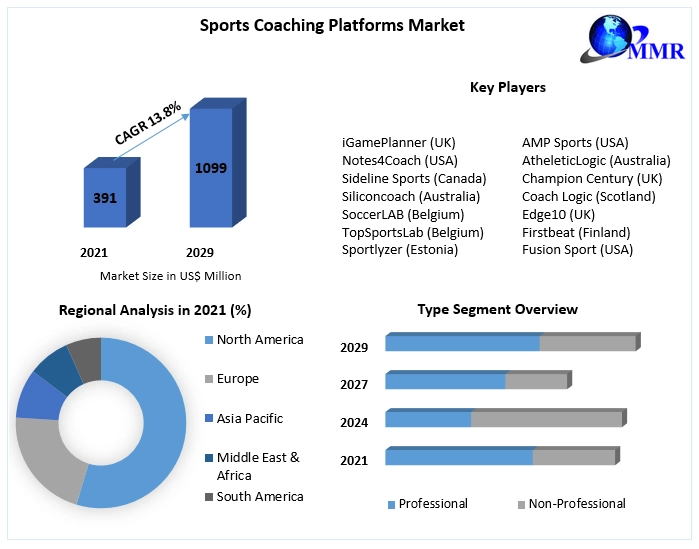
Source: Maximize Market Research
Sports video analysis software Coach Logic is gaining popularity, with over 40 national sports organizations worldwide using this solution. It enables collaborative video analysis, interactive feedback, and shared learning tools for sports teams.
A study published on ResearchGate found that the platform enables active involvement of athletes in performance analysis. Thus, leading to a positive team environment and peer-to-peer (P2P) collaboration.
Additionally, hybrid coaching ecosystems are on the rise. GameChanger Film Room, which auto-generates highlight reels for review, allows athletes to train smarter and more efficiently.
These innovations reflect a growing shift from intuition-based coaching to scientifically informed, data-led performance systems.
Flickit enables AI-Powered Football Drills
Indian startup Flickit develops an AI-powered smart football and app that delivers personalized drills and real-time performance tracking. The startup embeds motion sensors into the Flickit Smart Football, which connects with its mobile app to monitor dribbling patterns, track movement, and measure intensity.
It enables players to analyze strengths, identify improvement areas, and visualize their progress across 100+ structured drills. Additionally, the solution provides instant feedback through data-driven insights and allows athletes to refine skills with measurable precision.
Ballmecca offers Bite-Sized Sports Coaching
US-based startup Ballmecca designs a bite-sized sports coaching platform that connects beginners and top-tier college athletes for training. It enables users to receive detailed video analysis featuring expert voice-over commentary and customized drills that target specific growth areas.
In addition to video breakdowns, the platform allows athletes to request personalized demonstrations of techniques and allows targeted improvement with real-world mechanics. Moreover, Ballmecca supports broader athletic development by offering advice on team transitions, recruitment preparation, and balancing academics with sports commitments.
2. Virtual and Phygital Sports
Hybrid formats that merge physical activity with immersive digital environments improve modern sports engagement. The global phygital sports market is projected to grow from USD 1.54 billion in 2024 to USD 13.5 billion by 2034, reflecting a CAGR of 24.2%.
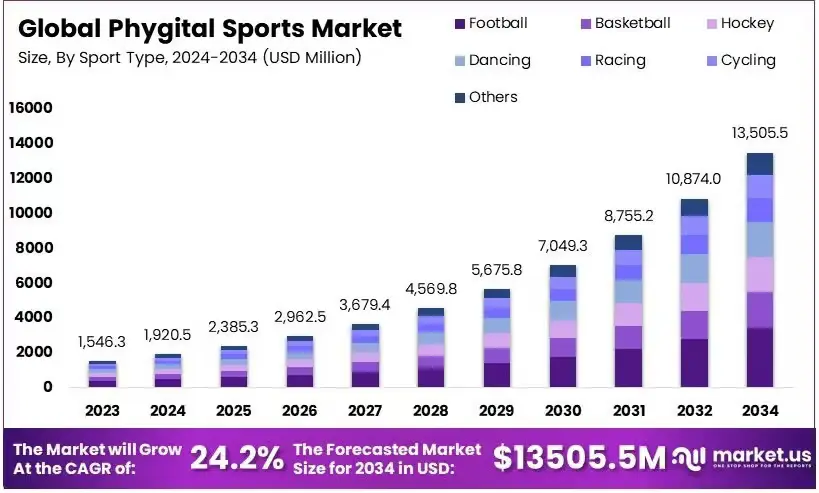
Source: Market.Us
According to Deloitte’s 2025 Sports Industry Outlook, advances in augmented reality (AR)/VR, motion capture, and gaming engines drive the rapid rise of interactive and hybrid sports formats.
TGL, launched in January 2025, offers a new phygital golf format. Players tee off into a simulator and finish on a real-time transformable green. This blends live competition with advanced broadcast features.
In professional training, VR platforms, like Rezzil, simulate high-speed game situations for elite football clubs to train cognitive reflexes and spatial awareness. Meanwhile, the Olympic Esports Series, launched by the International Olympic Committee, continues to grow as a competitive arena for digital athletes alongside traditional games.
Virtual and phygital stadiums are also emerging. Manchester City, in partnership with Sony, is developing a virtual replica of Etihad Stadium within the metaverse. It allows fans to attend matches as avatars with unlimited virtual seating.
Additionally, Cosm is delivering live sports and entertainment experiences with its immersive technology. This offers viewers a realistic, stadium-like sensation without leaving their city. Cosm’s Los Angeles, Dallas, and Salt Lake City venues leverage high-resolution, wraparound LED screens and spatial audio systems to simulate real-time sports events.
Phygital platforms, like Zwift, convert stationary workouts into multiplayer virtual races to combine athletic performance and gamified environments. In 2024, Zwift introduced its first in-person championship for top-ranked virtual cyclists.
PixelPaddle provides Metaverse Sports Stadiums
Canadian startup PixelPaddle builds immersive sports metaverse stadiums scaled over 20 000 square meters for multiplayer, virtual fan experiences. It uses photorealistic 3D modeling, live game data, motion capture, VR/AR technologies, and proprietary rendering engines to recreate real stadiums and athlete movements. The startup integrates blockchain-based NFT ticketing, player card NFTs, wearable NFTs, and digital wallets to secure access and transactions.
It features digital collectibles, branded immersive hallways, and social engagement zones for fan interaction across nine interconnected virtual floors. PixelPaddle adds real-time minigames like trivia battles, card duels, umpire decisions, and reflex tests to boost live engagement. It also deploys cloud-based microservices to support in-world sports sessions, virtual press conferences, and real-time multiplayer activities.
DevelAD develops an Interactive Virtual Sports Platform
Turkish startup DevelAD elevates sports experiences by enabling virtual interaction with live and simulated events. The platform engages users through immersive simulations, digital overlays, and virtual arenas, encouraging active participation beyond traditional passive viewing. Athletes use DevelAD to create virtual training environments, promote their profiles, and interact directly with digital audiences.
Fans access personalized content, earn tokenized rewards, and participate in gamified experiences that strengthen engagement and loyalty. The startup also integrates a crypto wallet to facilitate easy transactions and incentivized participation across multiple interaction points.
3. Innovations for Female Athletes
Historically, women were significantly underrepresented in sports science studies. Between 2014 and 2020, only 6% of published studies in major sports journals focused exclusively on women. However, product development, sports science, and athlete care are finally catching up to the unique needs of female athletes.
The global women’s sports market was valued at USD 145 billion in 2023. It is anticipated to grow at a CAGR of 8.5% between 2024 and 2030, reaching an estimated USD 256.67 billion by the end of the forecast period.
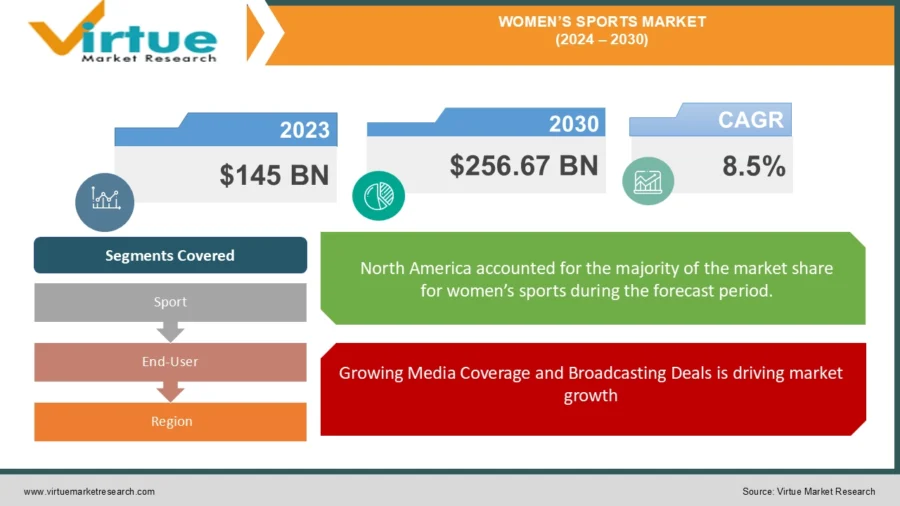
Source: Virtue Market Research
Sportswear brands are stepping up. Nike’s Well Collective, launched in 2023, collaborated with scientists and athletes to develop gear tailored to hormonal cycles, breast biomechanics, and pelvic health. The collection includes impact-specific sports bras and adaptive training programs for menstrual phases.
Startups are advancing sports-centric femtech solutions as well. Orreco’s FitrWoman app syncs workouts to menstrual cycles. Elite teams, including the USWNT and British Olympic squads, use this solution.
Wearables are evolving to reflect female-specific metrics. WHOOP’s 2024 update introduced the Menstrual Cycle Insights (MCI) feature. It offers cycle tracking and phase-based recovery adjustments.
At the institutional level, FIFA’s Female Health Project Snapshot, released in 2023, addresses injury prevention, especially for ACL injuries, which affect female players at higher rates. It also promotes menstrual equity and female-led coaching at the grassroots level.
eir improves Female Physiology-Focused Training
US-based startup eir develops a physiology-focused training platform to support female athletes through individualized, data-driven insights. It combines menstrual cycle tracking, physiological signal analysis, and wearable sensor data to generate real-time performance feedback.
The coaching dashboard within the mobile app delivers predictive analytics, personalized symptom forecasts, and evidence-based training strategies. Coaches monitor strain trends and access discreet communication tools to support menstrual health while protecting athlete privacy. The startup is HIPAA-compliant and has an encrypted infrastructure to ensure secure handling of sensitive data.
Medalist makes Skincare Products for Female Athletes
US-based startup Medalist offers skincare products to specifically address the performance and recovery needs of female athletes. It formulates solutions such as anti-chafe balms, cooling sprays, and cleansing wipes that protect skin exposed to sweat, friction, and environmental stressors.
The product line incorporates lightweight, non-comedogenic ingredients that refresh, hydrate, and soothe athletic skin without disrupting performance routines. Medalist also emphasizes portability, enabling athletes to maintain skin health on and off the field through compact, easy-to-use formats.
4. Fan Engagement and Experience
As media consumption habits evolve, sports organizations are transitioning from traditional broadcasts to interactive ecosystems. They prioritize personalized and immersive experiences that convert spectators into active participants.
A 2024 PwC survey highlights that younger audiences, particularly those aged 18-34, demand unique and immersive experiences. This prompts leagues and clubs to innovate their engagement strategies.
Augmented reality is enhancing fan interaction. The NBA’s AR app allows fans to play virtual pop-a-shot games by combining real-world environments with digital gameplay.
Similarly, LaLiga‘s official fantasy football manager game has seen significant engagement, with over eight million all-time downloads and more than 900 000 new users in the 2022-2023 season.
Personalized sports replays have become increasingly prevalent in elite leagues due to AI and computer vision. Companies, like WSC Sports, offer platforms that automatically generate customized highlight reels tailored to individual viewer preferences.
The National Basketball Association (NBA) has been at the forefront of adopting this technology. During the 2020 NBA Playoffs, WSC Sports‘ AI platform created over 67 000 personalized highlight clips that cater to diverse fan interests across various digital platforms.
The NBA further expanded its use of WSC Sports’ generative AI technology recently to automate multilingual content. This enables fans in countries like France, Brazil, and Spain to consume game highlights with voice-overs in their native languages.
Web3 tools are creating new loyalty layers. Launched in 2022, Australian Open’s AO ArtBall NFT collection featured 6776 unique NFTs, each corresponding to a 19cm x 19cm plot on the tournament’s tennis courts. When a match-winning shot landed on a specific plot, the associated NFT’s metadata was updated in real-time, allowing the holder to own a piece of that live moment.
The AO ArtBall holders were also granted complimentary seven-day Ground Passes for the second week of the Australian Open, access to other major international sporting events, limited-edition merchandise, and exclusive behind-the-scenes content.
Thumbo facilitates Gamified Fan Engagement
US-based startup Thumbo develops a gamified fan engagement platform that activates live audiences during downtime at sports events. It enables organizers to run stadium-wide contests such as trivia, cheer voting, and polls that fans join in real time through their phones. The platform captures participation metrics, contact details, and behavioral data to support personalized marketing and sponsorship strategies.
It includes built-in loyalty features such as point systems, prize rewards, and influence over game-day experiences. Thumbo integrates with Jumbotron displays and mobile devices to deliver interactive content that is visible to all attendees simultaneously. It supports branded sponsor activations and real-time feedback collection, turning passive breaks into high-value engagement moments.
Skyrim.AI streamlines Personalized Sports Replays
Skyrim.AI develops a spatial sports media platform that delivers personalized, immersive replays for fans and broadcasters. It captures volumetric data from live events and reconstructs game moments in 3D, enabling users to pause, rewind, and explore plays from any angle. The system works across devices, including smartphones, computers, and mixed reality headsets, without disrupting existing venue infrastructure.
It supports detailed playback of complex actions such as a gymnast’s routine or a batter’s swing, enhancing storytelling and game analysis. Broadcasters integrate Skyrim.AI with existing workflows and overlay content from fantasy sports platforms and data providers like SportsRadar.
5. Sports Wearables
Wearable technology has evolved from basic fitness tracking to integral tools for performance optimization, injury prevention, and recovery monitoring in amateur and professional sports. The sports wearable devices market is expected to expand from USD 45.18 billion in 2025 to USD 96.7 billion by 2034, reflecting a CAGR of 8.82%.
Elite athletes are increasingly relying on biometric performance trackers to fine-tune training regimens. Catapult, utilized by organizations across the NFL, Premier League, and NCAA, offers GPS-enabled vests that monitor metrics such as distance, sprint load, and player exertion.
Continuous health monitoring is also gaining prominence. The Oura Ring 4 tracks heart rate, body temperature, sleep patterns, and stress levels. Its lightweight, titanium design houses advanced sensors that deliver continuous data and allow athletes to customize their training and recovery strategies.
Advances in smart insoles and motion sensors are enhancing diagnostic techniques. Companies like Plantiga and Driveline Baseball develop pressure-mapping wearables embedded in footwear to analyze gait, jump load, and asymmetries. These tools improve rehabilitation programs for basketball, track and field, and baseball.
Smart helmets are also improving athlete safety. In 2025, the NFL introduced seven new top-performing helmet models that contributed to a record low number of concussions – a 17% reduction compared to the 2023 season.
Additionally, the NFL adopted Guardian Caps and soft-shell helmet covers in its practices and games. These caps reduce concussions by up to 50% among certain position groups during preseason practices.
Further, the consolidation of wearables with sports tech platforms is streamlining data analysis. Firstbeat Sports aggregates data from various wearable devices into centralized dashboards. This enables coaches and medical teams to make informed decisions regarding athlete readiness and workload management.
Dyamotech makes a Smart Headband for Impact Monitoring
UK-based startup Dyamotech provides a smart headband that monitors head impacts during sports to support early detection of potential concussions. The device measures the frequency, direction, timing, and severity of impacts using embedded G-force and motion sensors. It alerts users in real time through a flashing red light when an impact exceeds a defined threshold.
The accompanying app provides post-session reports detailing individual impact events, accessible without continuous phone connectivity. The headband features waterproofing, machine washability, and durable, lightweight construction suitable for various sports. It also includes Bluetooth 5.2, offline memory, and a traffic light warning system for intuitive use.
Engo manufactures an Advanced Heads Up Display
French startup Engo builds an advanced heads-up display integrated into lightweight eyewear for endurance athletes. It projects real-time performance metrics such as pace, heart rate, and power directly into the athlete’s line of sight. The display uses a photonic waveguide and ultra-lightweight design to ensure clear, distraction-free viewing without obstructing natural vision.
Athletes customize dashboards with over 40 selectable metrics and navigate displays using simple hand gestures. Engo integrates with Garmin, Apple Watch, Suunto, Android, and iPhone devices to deliver seamless connectivity across training systems. It also offers a photochromic lens option that adapts to changing light conditions for outdoor activities.
6. Advanced Sports Equipment
Performance-driven innovation in sports equipment is reshaping how athletes train, compete, and recover. The global sports equipment market was valued at USD 331.4 billion in 2021 and is projected to grow at a CAGR of 6.4% between 2022 and 2030.
Material innovation is leading the way. Brands are incorporating graphene, carbon fiber, and basalt fibers into rackets and bats for improved shock absorption and lighter swing weight. For example, HEAD’s Graphene 360+ tennis racquets deliver higher energy return without compromising control, adopted by ATP pros like Novak Djokovic.
Adidas’ 4DFWD running shoes, built with 3D-printed lattice midsoles, adapt cushioning and propulsion based on biomechanics. Similarly, Formlabs and New Balance are developing custom insoles and cleats using athlete foot scans and gait data.
Smart integration is making equipment more intelligent. Wilson’s X Connected Basketball is a smart basketball equipped with embedded sensors that track shooting performance metrics such as shot arc, rotation, and shooting percentage in real time. This allows players to monitor their performance and make data-driven improvements to their game.
Protective equipment is evolving with embedded sensors and responsive materials. Riddell’s Axiom football helmet uses a head impact telemetry system (HITS) to detect hits and assess concussion risks. Meanwhile, Reebok is re-introducing its Energy Return Shield (ERS), which replaces hollow tubes used in the original ERS with nitrogen-infused foam pads.
Thermoregulation and climate-adaptive gear are gaining relevance as athletes face extreme and fluctuating environments. Nike’s Aerogami system integrates humidity-reactive vents that open and close based on the wearer’s sweat and body temperature. This adaptive feature reduces core body temperature in warm conditions.
43 Degree Sports produces Heated Hockey Bags
US-based startup 43 Degree Sports makes a heated hockey bag to sanitize, dry, and pre-warm athletic equipment safely and efficiently. The bag uses a patented heating element that wraps around its interior, maintaining a consistent 43°C temperature to eliminate bacteria and odors.
It features 600D durable fabric, custom waterproof zippers, impact-resistant lining, and dedicated no-heat pockets for personal items. Athletes adjust heat settings through a remote control and benefit from a large mesh laundry insert for organized packing. The bag operates safely indoors, in hotels, or on the move without requiring external drying equipment.
O-DAMP offers Fluid Dynamics-Powered Helmets
Italian startup O-DAMP provides helmets that use fluid dynamics technology to manage and dissipate impact forces during athletic collisions. It integrates specially engineered fluid channels within the helmet liner that redirect and absorb kinetic energy upon impact.
The design minimizes peak acceleration forces transmitted to the head, enhancing protection without increasing helmet weight or reducing ventilation. The helmet structure adapts to impacts from multiple angles, improving safety in dynamic, real-world conditions.
7. Smart Stadiums and Venues
Stadiums are evolving into hyper-connected, multi-sensory environments to enhance fan engagement, operational efficiency, and revenue generation. According to Research and Markets, the global smart stadium market is projected to reach USD 38.69 billion in 2029, growing at a CAGR of 23.6%.
Next-gen connectivity is foundational to smart venues. Levi’s Stadium in Santa Clara, home to the San Francisco 49ers, has over 400 miles of fiber-optic cable and one of the strongest Wi-Fi networks in the NFL. This infrastructure supports high-bandwidth activities, like in-seat mobile ordering, instant replays, and real-time navigation, to improve fan experiences.
Similarly, Tottenham Hotspur Stadium has partnered with Hewlett-Packard Enterprise (HPE) to build over 1600 wireless access points. Thus, providing 100% mobile coverage and enabling 65% of matchday attendees to stream live video simultaneously. Fans also receive location-specific offers through beacons in concourses and hospitality areas.
Hybrid entertainment models are on the rise. FIFA Fan Festivals have transformed public viewing by combining live match screenings with cultural activities, music, and interactive experiences.
The 2022 FIFA Fan Festival in Doha’s Al Bidda Park attracted around 1.8 million visitors. It offered fans without tickets a vibrant and inclusive way to engage with the tournament.
In the same event, Cisco’s Connected Stadium solutions employed Wi-Fi heatmaps and mobile app integration to analyze crowd movement. This enabled authorities to redirect foot traffic in overcrowded zones and resulted in a 22% reduction in incidents.
Further, smart stadiums utilize IoT sensors to control lighting, HVAC, and waste management based on real-time occupancy and environmental data. For instance, the Mercedes-Benz Stadium features smart parking systems with license plate recognition to guide vehicles efficiently while reducing congestion and wait times.
At entry points, Evolv deploys its automated screening technology to enable seamless crowd flow while enhancing security through contactless scanning.
Safety and security are also receiving tech upgrades. Facial recognition is being piloted in various stadiums to facilitate touchless entry for pre-registered fans. For instance, Idemia’s MorphoWave Compact was tested at Japan’s Level5 Stadium for fans to gain entry by simply waving their hands over a scanner.
Additionally, some venues employ crowd modeling and real-time traffic data to automate evacuation routes during emergencies. Altertus offers a solution for sending personalized guidance to fans via app notifications and digital signage, which optimizes evacuation efficiency and safety.
Feldspar builds Sensor-Enabled Running Track
UK-based startup Feldspar builds a sensor-enabled running track that captures real-time performance data to enhance athletic training and live event experiences. It integrates advanced sensors within a modular, high-performance surface that tracks every step with precision while maximizing energy return. The flooring uses proprietary materials that reduce fatigue, lower injury risks, and extend athletic performance across sessions.
Athletes access instant analytics through connected platforms, while spectators experience dynamic play-by-play updates in physical venues and online broadcasts. Moreover, the modular design enables rapid installation across indoor tracks, stadiums, and temporary event sites without disrupting existing infrastructure.
PodPlay develops a Sports Club Management Solution
US-based startup PodPlay develops a sports club management platform that streamlines court reservations, membership administration, and event programming. It enables clubs to automate court bookings, assign players using an algorithmic system, and manage peak and off-peak pricing to maximize utilization.
The platform integrates optional features such as digital scoreboards, video replay hardware, and autonomous operating modes that reduce staffing requirements. Clubs control branding through a white-label app experience across iOS, Android, mobile web, and desktop platforms. PodPlay also connects players with coaches, supports event scheduling for tournaments and clinics, and delivers business analytics through integrated reporting dashboards.
8. Tech-Assisted Match Analysis
Once limited to post-match reviews, match analysis has become live, predictive, and player-specific. This is due to the integration of AI, computer vision, and biometric tracking, among other emerging technologies.
The global sports analytics market is projected to be valued at USD 3.73 billion in 2025 and is anticipated to grow to USD 13.88 billion by 2030, reflecting a CAGR of 30.04% during this period.
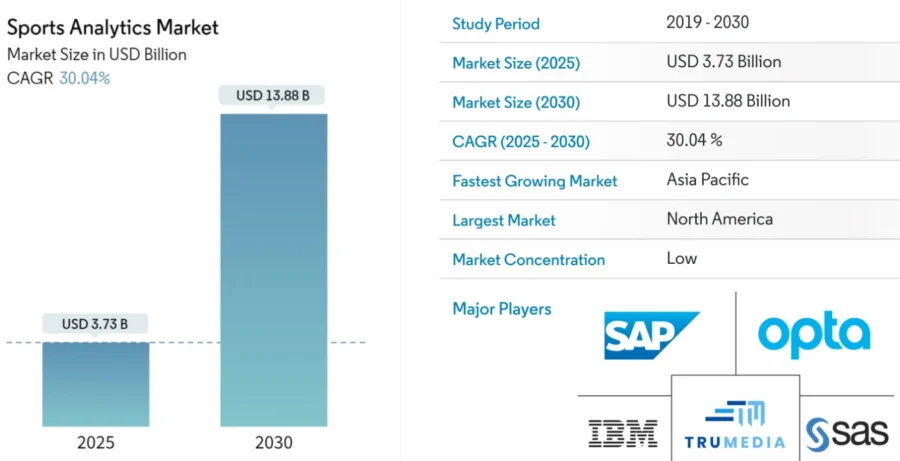
Source: Mordor Intelligence
Computer vision and automated video analysis are at the core of modern match analysis. For example, Hudl offers Wyscout, an AI-based platform that automatically tags passes, shots, ball recoveries, and player positioning. Coaches across football, rugby, and basketball use these tools to receive instant feedback during halftime or immediately after matches.
Ball and equipment tracking has added object-specific intelligence to match analysis. At the 2022 FIFA World Cup, Adidas debuted the Al Rihla ball with a 500Hz IMU sensor, developed with KINEXON, suspended at its center. This sensor captured real-time data on speed, spin, and positioning that enabled officials to validate offside calls and other decisions with greater accuracy.
The success of the connected ball technology in the 2022 World Cup led to its use in the FIFA Women’s World Cup 2023 as well. Here, a similar technology was employed to assist in semi-automated offside decisions and provide fans with real-time data on shot speed and distance.
It uses machine learning and computer vision to generate insights on player movement, spacing, and defensive plays. This allows broadcasters, analysts, and coaches to adjust strategies mid-game.
Additionally, Second Spectrum’s collaboration with AWS led to the development of AR features and real-time statistics to enhance the viewing experience for fans. Its CourtVision platform provides interactive graphics and overlays that visualize player tracking data, offering a deeper understanding of the game’s dynamics.
Post-match reports and player development have become highly personalized. Spiideo’s automated video analysis system, Spiideo Perform, empowers athletes and coaches to review games or training sessions.
Alai advances Real Time Football Analytics
US-based startup Alai designs a real-time football analytics platform that detects defensive vulnerabilities and supports immediate tactical adjustments during live matches. It uses AI to analyze every second of play, identify rest defense weaknesses, and generate risk-ranked alerts for coaching staff.
The platform integrates with existing workflows, including Hudl Sportscode and Catapult Focus, requiring no additional hardware or staffing changes. Analysts access instant half-time reports, performance tracking dashboards, and match-by-match comparisons to benchmark defensive improvements. Alai categorizes vulnerabilities from minor to critical, allowing clubs prioritize in-game decision-making with data-backed urgency.
Khel.ai enables Cricket Analysis Automation
Indian startup Khel.ai offers an AI-driven cricket analysis platform that automates ball tracking, event tagging, video clipping, and real-time insights generation. It uses computer vision models is trained on millions of cricket videos to detect deliveries, track ball trajectories, and classify player actions without manual input.
The platform automatically segments matches into searchable highlights such as wickets, boundaries, maidens, and milestones. Analysts and players visualize performance through dashboards featuring match timelines, player rankings, ball speed data, and impact zones. Khel.ai also offers cloud-based storage, offline data syncing, and integrated match libraries for scalable performance management.
9. Athlete Wellness and Mental Health
Wellness and mental health have moved to the forefront of professional and amateur sports, evolving from behind-the-scenes support to a core component of athlete performance and longevity. Psychological health is now recognized as critical to athletic performance.
High-profile athletes, like Simone Biles, Naomi Osaka, and Kevin Love, have helped destigmatize mental health by publicly addressing anxiety, burnout, and depression. In response, leagues have introduced mandatory mental wellness programs to improve access to therapists, mindfulness coaches, and crisis support lines.
The NBA’s Mind Health initiative supports the mental well-being of players, coaches, and referees across its leagues and provides licensed mental health providers and mental performance consultants. Similarly, the NFL offers mental wellness resources through NFL Life Line – a confidential hotline connecting current and former players with trained counselors.
Digital mental health platforms are also integral to athlete wellness as they offer tools tailored to the unique demands of sports performance. Calm has partnered with major sports organizations to provide mindfulness resources to athletes.
FIFA designated Calm as the “Official Mindfulness and Meditation Product” for the 2022 World Cup in Qatar, which grants players, staff, and volunteers free access to the app’s features like guided meditations, sleep aids, and relaxation techniques.
Similarly, Champion’s Mind includes modules on goal setting, emotional regulation, visualization, and mindfulness. Developed by sports psychologist Dr. Jim Afremow, the platform has been adopted by various athletic programs, including Black Hills State University, to support student-athlete mental health.
Training environments are being redesigned for psychological safety. For instance, Manchester City has integrated sports psychology into its training framework. David Young, a first-team sports psychologist, has discussed the challenges faced by players and coaching staff, especially during unprecedented times like the COVID-19 pandemic.
Likewise, FC Bayern Munich has prioritized psychological safety through its “Mental Health Awareness Month” initiative. The program featured over 40 workshops for staff, coaches, players, and parents, and trained 15 employees as mental health first aiders. The Robert Enke Foundation honored the club for FC Bayern Munich’s commitment to promoting mental health in youth sports.
Awareness and prevention initiatives are playing larger roles, especially among youth athletes. Athletes for Hope’s “Whole Being Athlete” program provides educational workshops, awareness events, and storytelling campaigns to encourage athletes to prioritize mental wellness and challenge negative perceptions.
The Hidden Opponent, a nonprofit founded by former Division I athlete Victoria Garrick, focuses on student-athlete mental health advocacy. USA Lacrosse also collaborated with The Hidden Opponent to highlight student-athletes nationwide who are actively working to break the stigma around mental health.
EMOTAB empowers Athlete Emotional Wellbeing
Spanish startup EMOTAB develops an AI-powered platform that monitors and analyzes the emotional well-being of athletes. It captures psychological and behavioral data during training and matches using real-time emotional key performance indicators derived from machine learning models.
The platform processes massive data volumes to measure mental activation levels, stress responses, and emotional recovery patterns objectively. It presents individualized and group-based reports, providing coaches, medical staff, and athletes with actionable insights. EMOTAB also integrates injury recovery analytics by linking emotional states to mental rehabilitation timelines.
Better Together offers Athlete Mentoring & Wellness Programs
US-based startup Better Together provides an athlete mentoring and wellness platform that supports young athletes’ mental skills development through education and lived experience sharing. It connects high school and college athletes with trained mentors who deliver resilience, mindset, goal-setting, and positivity training through structured virtual sessions.
The platform combines mental skills curriculum, one-on-one mentoring, and team-based workshops to strengthen mental performance alongside athletic growth. Sports clubs and teams receive customized programming that complements athletic training with emotional and psychological support. Parents also access educational resources that guide them in fostering communication, balance, and mental well-being for athlete development.
10. Sustainable Sports
Sustainability is becoming a defining value in the global sports industry, with governing bodies, clubs, and sponsors increasingly prioritizing environmental responsibility. The sustainable sports market size was valued at USD 26.24 billion in 2024 and is expected to grow at a CAGR of 7.9% till 2032.
This January, the Sport Industry Group (SIG), in partnership with Nielsen Sports and Think Beyond, released the Sports Industry Report 2025. Based on it, while 56% of fans view sport as environmentally positive, only 21% of industry professionals agree. Still, 70% of fans and nearly 90% of leaders believe sports organizations must take more responsibility for sustainability and social issues.
Carbon-neutral stadiums and infrastructure are leading the shift. Forest Green Rovers has been recognized by FIFA as the “world’s greenest football club“. It was certified by the United Nations as the first carbon-neutral football club under the UNFCCC’s Climate Neutral Now initiative.
The Paris 2024 Olympics were one of the most sustainable Games in history, with 95% of venues either existing or temporary. It reduced athlete travel emissions through verified offsetting, phased out single-use plastics, and implemented circular waste management systems.
Eco-friendly sportswear and equipment are reshaping athlete apparel and fan merchandise. The global sustainable sportswear market is projected to reach USD 3.96 billion by 2031
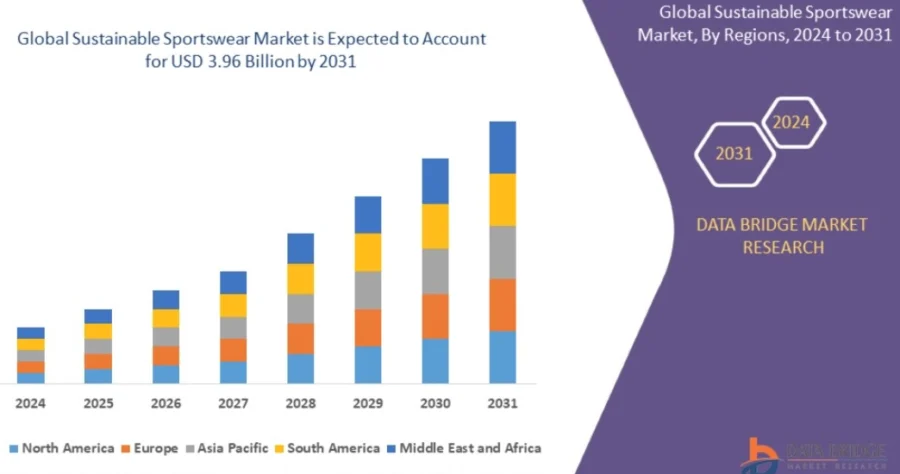
Source: Data Bridge Market Research
Nike’s “Move to Zero” initiative focuses on achieving zero carbon and zero waste. The company reuses materials, creates new sustainable textiles, runs recycling and refurbishment programs, and reduces emissions and water use in production.
Adidas also introduced the FUTURECRAFT.LOOP, which uses reusable thermoplastic polyurethane (TPU) to create recyclable running shoes. Customers return worn shoes, and Adidas breaks them down to make new performance footwear, demonstrating a closed-loop process.
Sustainable sponsorship and fan engagement are evolving, too. Through initiatives like the Better Futures Fund and partnership with UNICEF, Formula E engages fans in sustainability efforts, including climate pledges and community projects.
Likewise, SailGP has established the Impact League, a secondary leaderboard that scores teams on sustainability performance across criteria like carbon reduction and community engagement. Top-performing teams receive prize money to donate to sustainability partners.
MakinH manufactures Self-Wetting Hockey Balls
Belgian startup MakinH manufactures a self-wetting hockey ball, rewetta, that reduces the need for field irrigation while maintaining high-performance playing conditions. It integrates a specialized water-retention system within the ball, allowing a minimal amount of water to be gradually released during play.
Moreover, rewetta’s design enables consistent friction, ball speed, and player control, even on dry or partially watered fields. Its construction optimizes water efficiency by localizing hydration where it is most needed, eliminating extensive surface watering.
VIDAR Sport produces Eco-Friendly Sportswear
German startup VIDAR Sport offers eco-friendly sportswear using its proprietary fibers. It sources TENCEL Lyocell from FSC- and PEFC-certified wood and converts it into fibers through a closed-loop process that recycles almost all of the solvents.
The fabrics deliver breathability, moisture-wicking capability, thermoregulation, and natural bacterial resistance without chemical additives. The startup integrates SEACELL fibers by blending sustainably harvested Icelandic seaweed with cellulose through an energy-efficient production method that preserves the seaweed’s antioxidant properties after repeated washes.
Discover all Sports Tech Trends, Innovations & Startups
Sports organizations will leverage smart betting solutions, fan data monetization strategies, and AI-assisted officiating to shape the next era of competition. The revival of traditional sports will also play a critical role in connecting modern audiences with timeless athletic traditions. As technology and culture continue to evolve, these innovations will reshape the future of athletic performance, fan experiences, and sports businesses.
The Sports Trends & Startups outlined in this report only scratch the surface of trends that we identified during our data-driven innovation & startup scouting process. Identifying new opportunities & emerging technologies to implement into your business goes a long way in gaining a competitive advantage.
